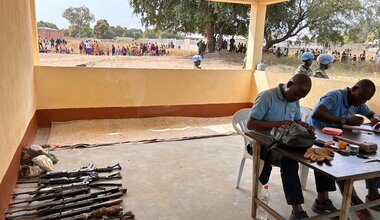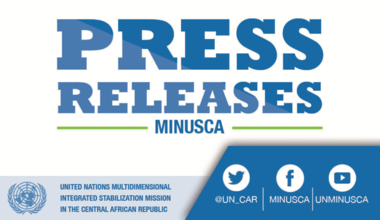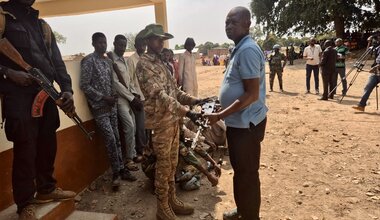PAVING THE WAY FOR PEACE: 3R COMBATANTS LAY DOWN THEIR ARMS IN NORTH-WESTERN CAR
Sanguere-Lim, CAR – As the disarmament team approached, the Retour, Réclamation et Réhabilitation (3R) combatants stood in two orderly lines expectantly, youthful faces and graying heads alike. Some carried weapons of war; others ammunition — the very items on which their eligibility for the disarmament, demobilization, and reintegration process they were about to embark on depended.
Well-wishes rang out from the small crowd of locals who had gathered to see the combatants off as they walked from the 3R assembly point towards the nearby makeshift disarmament site that the National Disarmament, Demobilization, Reintegration, and Repatriation Programme Implementation Unit (UEPNDDRR) was setting up. A few minutes earlier, as if on cue, the sound of song in the distance had pierced the air in Sanguere-Lim, Koui Sub-Prefecture, in the Central African highlands, as a group of young scouts decked in their legendary uniforms marched past the assembled combatants, putting an unexpected festive spin to the momentous day ahead.
Music filled the air at the disarmament site too – this time, part of a UEPNDDRR awareness campaign – as a song blared out from loudspeakers, calling on Central Africans to lay down their arms: “In order to go to school, to cultivate the fields or for any kind of livelihood, lay down your weapons, for peace …”.
A UEPNDDRR banner on display informed the ever-growing crowd of onlookers of an ongoing “awareness campaign for the voluntary surrender of weapons without fear of prosecution” and outlined the objectives of the ongoing activities: “voluntarily handing over a weapon of war in your possession to the UEPNDDRR contributes to peace, security, social cohesion, and peaceful coexistence”.

The disarmament and demobilization operations in Sanguere-Lim, conducted from September to October 2025 by the UEPNDDRR, were the latest in a series of ongoing operations launched earlier in July. These operations followed the signing of a landmark peace agreement between the Government of the Central African Republic and the 3R and Unité pour la Paix en Centrafrique (UPC) armed groups on 19 April 2025 in N’Djamena, Chad – marking their return to the CAR peace process (Accord politique pour la paix et la réconciliation en République centrafricaine (APPR-RCA). The DDR operations are supported by the United Nations peacekeeping mission (MINUSCA), in line with its mandate, as has been the case since December 2018 when the Government launched its national DDRR programme. MINUSCA has since been providing extensive financial, logistical, technical and security support for the smooth running of operations.
Abel Delatid, aged 25, who joined the 3R in 2017, was among the combatants disarmed in Sanguere-Lim. “I heard about the peace agreement in N’Djamena through awareness-raising by MINUSCA and local authorities. I am looking forward to vocational training to start a new life as I lost my leg during fighting,” he said after surrendering his weapon.
With the disarmament activities in full swing, a few obligatory stops awaited the combatants: the handover weapons or ammunition to the UEPNDDRR team; a body search; registration and receipt of a disarmament certificate; a medical check-up; choice of vocational training; pickup of reinsertion allowance; and a starter kit with a few essential items to embark on their new lives ahead.
“The country has not progressed because of multiple crises. There will be peace and progress if the government and armed groups honor their commitments to stop the fighting,” said 56-year-old Ibrahim Oumarou Adam, echoing the message of the song on repeat from the UEPNDDRR loudspeakers, of how war stalls life and progress.
For his part, Aroun Isa Oumar expressed a desire to leave behind the tough years spent in the bush. He hoped to receive training in order to join the national army – a recurrent wish among many combatants – perhaps driven by a deficit of information about available programmes supporting their socio-economic reintegration.

Time and time again, UEPNDDRR Awareness Campaign Officer, Jean Christophe Namyona, was compelled to brief the ex-combatants making a stop at his desk to choose a preferred vocational training or income-generating activity of their choice (commerce, husbandry, carpentry, among others), should they not be eligible to join the national armed forces.
Disarmament and demobilization operations are guided by the 2016 National DDR Strategy, which outlines specific eligibility criteria for the DDR process. For example, ex-combatants seeking to join the national armed forces must be between 18 and 25 years old. A weapons-to-munitions threshold of 10 percent must also be maintained. Eligibility further depends on the possession of a functional or reparable weapon, or the surrender of 200 rounds of ammunition, eight grenades, or 10 rockets.
Among the 3R combatants previously disarmed in the area was Mbekaka Ursula Aicha, a 29-year-old mother of two and the only female ex-combatant to join the DDR process in the locality. She had joined the 3R movement three years earlier, driven by a sense of protest against what she described as the marginalization of her community. “I agreed to disarm following the call by the President to return to the country and work for peace, as well as in accordance with orders from the 3R leadership. Now that we have laid down our weapons, peace is possible,” she said.
The Sub-Prefect of Koui, Larry Nordine Mahalba, stressed the importance of disarmament and demobilization in the locality and commended MINUSCA support. “For five years, the 3R occupied this region. MINUSCA has supported us on multiple levels – bringing relief to a traumatized population. It is a major step forward to bring 3R elements who are now awaiting their socio-economic reintegration out of the bush,” he added.
“Crucially, disarmament and demobilization operations contribute to pacifying communities, thereby advancing the key MINUSCA mandated task to protect civilians,” noted MINUSCA Coordination Officer, Wilfried Relwende Sawadogo.
UENPDDRR Chief of Operations, Jean-Wilfried Lawet, lauded MINUSCA as a “longstanding and key DDR partner” of the CAR. “In just a short period of time, a significant number of 3R elements have been disarmed.” The operations in Sanguere-Lim were preceded by similar operations from July to August in Maloum, Basse-Kotto Prefecture (central CAR) and Koui (Ouham-Pendé Prefecture) targeting 3R, UPC and anti-Balaka combatants, resulting in a total of 575 demobilized and disarmed elements to date.
For Sanguere-Lim resident Adama Yaouba, life has turned a corner thanks to disarmament in the locality: “War destroys countries, shatters families, and divides communities. Weapons do not protect—they pit people against one another and sow fear. Today, armed groups have laid down their arms, and everything has changed. Before, we never slept peacefully; we lived in constant fear, always on edge. But now, I can sleep calmly, free from worry. My children are safe too, and that is what matters most to me.”
“I was disarmed during previous operations, and I encourage others to follow in our footsteps by rejoining the peace process,” said the 3R Political Coordinator, Yaya Amadou, who highlighted the “exceptional partnership and working relationship” that enabled the achievement of encouraging results in the north-west and expressed optimism for continued collaboration in future disarmament and demobilization operations.
“The time for war is over, and now is the time to make peace,” maintained Yaya Amadou as the 3R ex-combatants boarded the UEPNDDRR vehicle that would transport them to the next phase of DDR – socio-economic reintegration – and their new lives ahead.
 UN
UN United Nations Peacekeeping
United Nations Peacekeeping





